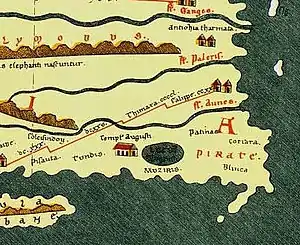Tyndis
Tyndis (Ancient Greek: Τύνδις[1]) was an ancient Indian seaport/harbor-town mentioned in the Graeco-Roman writings. According to the Periplus of the Erythraean Sea, Tyndis was located north of port Muziris (Muchiri) in the country of the Keprobotos (present-day Kerala).[2]

There are references to a port with the name Tondi, on the Kerala coast, in the early Tamil texts. It was under the control of the Chera rulers (probably via/under a collateral branch).[3][4] No archaeological evidence has been found for Tyndis.[3]
Different variations of the name
Sources
Graeco-Roman descriptions
- Periplus of the Erythraean Sea (c. 1st century[2]), 54-56, mentions Tyndis as "a well known village on the coast".
- Pliny the Elder (1st century) - "the Caelobothras ruled a kingdom extending to Tyndis (on the north-west)".[2]
- By the time Claudius Ptolemy (2nd century) wrote, Tyndis had grown large enough for him to call it (Geography 7.1.8) a town (polis).[5]
- Tabula Peutingeriana locates Tondis north of Muziris (north of Templ Augusti and Lacus Muziris).[2]
Location
The location of Muziris provides clues for the location Tyndis, which was 500 stades (92 km) north of it (by river and sea).[2]
In ancient times, Tyndis held close connections with Chera kingdom. The historic archives documented the Chera Kingdom as the powerful Tamil Kingdom whose turf extends the entire present-day state of Kerala, Kanyakumari and expanding up to Kongu Nadu.
The perfect array of religions, customs, languages, and traditions over the flow of time reflects in the prosperous heritage of Malabar. Upon reaching the Tyndis port, they further traveled to the inlands using smaller boats and then by carts to the hill stations of Wayanad or Coorg, and then on wards in search of spices and precious herbs.
The exact location of the port is still unknown. Possible candidates include the following modern locations:
See also
References
- Periplus of the Erythraean Sea, 53 and 54
- Gurukkal, R., & Whittaker, D. (2001). In search of Muziris. Journal of Roman Archaeology, 14, 334-350.
- Selvakumar, V. (25 November 2016). K. S. Mathew (ed.). Imperial Rome, Indian Ocean Regions and Muziris: New Perspectives on Maritime Trade. Taylor & Francis. pp. 274–76. ISBN 978-1-351-99752-2.
- "Classical Indo-Roman Trade". Economic and Political Weekly. 48 (26–27). 5 June 2015.
- Lionel Casson 2012, p. 213.
- Gurukkal, R., & Whittaker, D. (2001). In search of Muziris. Journal of Roman Archaeology, 14, 334-350.
Bibliography
- Lionel Casson (2012). The Periplus Maris Erythraei: Text with Introduction, Translation, and Commentary. Princeton University Press. ISBN 1-4008-4320-0.